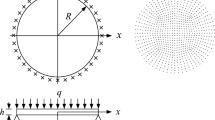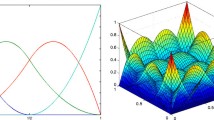Abstract
In this article, a novel numerical solution procedure is proposed to evaluate the upper bound limit load multipliers for thin plate problems, which incorporates the C1 natural element method (C1NEM) with a direct iteration algorithm. Due to its remarkable interpolation property to the nodal function and the nodal gradient values, the C1NEM with the C1- continuous trial function is used here to deal with the upper bound limit analysis problem of perfectly rigid-plastic plates. The relevant discrete mathematical programming formulation is established based on the kinematic theorem of plastic limit analysis, and a direct iteration algorithm with the advantages of simple solution formula and easy procedure implementation is presented to solve it. Several representative examples governed by the von Mises yield criterion are investigated. The numerical solutions obtained in this paper are reasonable and satisfactory, and are in good agreement with the previously reported results.
Similar content being viewed by others
References
Hodge PG (1963) Limit analysis of rotationally symmetric plates and shells. Prentice-Hall, New Jersey
Save MA, Massonnet CE (1972) Plastic analysis and design of plates, shells and disks. North-Holland, Amsterdam
Zyczkowski M (1981) Combined loadings in the theory of plasticity. Polish Scientific, PWN and Nijhoff
Xu BY, Liu XS (1985) Plastic limit analysis of structures. China architecture & building Press, Beijing
Lubliner J (1990) Plasticity theory. Macmillan, New York
Yu MH, Ma GW, Li JC (2009) Structural plasticity limit, shakedown and dynamic plastic analyses of structures. Springer, New York
Hodge PG, Belytschko T (1968) Numerical methods for the limit analysis of plates. J Appl Mech 35(4): 795–802
Nguyen HD (1976) Direct limit analysis via rigid-plastic finite elements. Comput Methods Appl Mech Eng 8(1): 81–116
Capsoni A, Corradi L (1999) Limit analysis of plates-a finite element formulation. Int J Numer Methods Biomed Eng 8(4): 325–341
Turco E, Caracciolo P (2000) Elasto-plastic analysis of Kirchhoff plates by high simplicity finite elements. Comput Methods Appl Mech Eng 190(5–7): 691–706
Corradi L, Vena P (2003) Limit analysis of orthotropic plates. Int J Plasticity 19(10): 1543–1566
Corradi L, Panzeri N (2003) Post-collapse analysis of plates and shells based on a rigid-plastic version of the TRIC element. Comput Methods Appl Mech Eng 192(33–34): 3747–3775
Tran TN, Kreissig R, Staat M (2009) Probabilistic limit and shakedown analysis of thin plates and shells. Struct Saf 31(1): 1–18
Le CV, Nguyen-Xuan H, Nguyen-Dang H (2010) Upper and lower bound limit analysis of plates using FEM and second-order cone programming. Comput Struct 88(1–2): 65–73
Capsoni A, Vicenteda Silva M (2011) A finite element formulation of Mindlin plates for limit analysis. Int J Numer Methods Biomed Eng 27(1): 143–156
Belytschko T, Lu YY, Gu L (1996) Element free Galerkin methods. Int J Numer Methods Eng 37(2): 229–256
Liu WK, Jun S, Zhang YF (1995) Reproducing kernel particle methods. Int J Numer Methods FL 20(8–9): 1081–1106
Duarte CA, Oden JT (1996) An h-p adaptive method using clouds. Comput Methods Appl Mech Eng 139(1–4): 237–262
Atluri SN, Zhu T (1998) A new meshless local Petrov-Galerkin (MLPG) approach in Comput Mech. Comput Mech 22(2): 117–127
Chen JS, Wu CT, Yoon S, You Y (2001) A stabilized conforming nodal integration for Galerkin mesh-free methods. Int J Numer Methods Eng 50(2): 435–466
Liu GR, Gu YT (2001) A point interpolation method for two-dimensional solids. Int J Numer Methods Eng 50(4): 937–951
Cueto E, Sukumar N, Calvo B, Martinez MA, Cegonino J, Doblar M (2003) Overview and recent advances in natural neighbour Galerkin methods. Arch Comput Methods Eng 10(4): 307–384
Le CV, Gilbert M, Askes H (2009) Limit analysis of plates using the EFG method and second-order cone programming. Int J Numer Methods Eng 78(13): 1532–1552
Le CV, Gilbert M, Askes H (2010) Limit analysis of plates and slabs using a meshless equilibrium formulation. Int J Numer Methods Eng 83(13): 1739–1758
Le CV, Askes H, Gilbert M (2010) Adaptive element-free Galerkin method applied to the limit analysis of plates. Comput Methods Appl Mech Eng 199(37–40): 2487–2496
Onate E et al (1994) A review of some finite element families for thick and thin plate and shell analysis. In: Onate E (ed) Recent Developments in finite element analysis. CIMNE, Barcelona, pp 98–111
Zienkiewicz OC, Taylor RL (2005) The finite element method. Butterworth-Heinemann, Oxford
Barros FB, de Barcellos CS, Duarte CA (2007) p-Adaptive C-k generalized finite element method for arbitrary polygonal clouds. Comput Mech 41(1): 175–187
Xiang JW, Chen XF, He ZJ, Zhang YH (2008) A new wavelet-based thin plate element using B-spline wavelet on the interval. Comput Mech 41(2): 243–255
de Barcellos CS, Mendonca PDR, Duarte CA (2009) A C (k) continuous generalized finite element formulation applied to laminated Kirchhoff plate model. Comput Mech 44(3): 377–393
Sukumar N, Moran B (1999) C-1 natural neighbor interpolant for partial differential equations. Numer Methods Part D E 15(4): 417–447
Fischer P, Mergheim J, Steinmann P (2010) On the C-1 continuous discretization of non-linear gradient elasticity: a comparison of NEM and FEM based on Bernstein–Bezier patches. Int J Numer Methods Eng 82(10): 1282–1307
Rajagopal A, Fischer P, Kuhl E, Steinmann P (2010) Natural element analysis of the Cahn-Hilliard phase-field model. Comput Mech 46(3): 471–493
Chen G, Liu YH (2006) Numerical theories and engineering methods for structural limit and shakedown analyses. Science press, Beijing
Sukumar N, Moran B, Belytschko T (1998) The natural element method in solid mechanics. Int J Numer Methods Eng 43(5): 839–887
Sukumar N, Moran B, Semenov AY, Belikov VV (2001) Natural neighbour Galerkin methods. Int J Numer Methods Eng 50(1): 1–27
Farin G (1990) Surfaces over Dirichlet tessellations. Comput Aided Geom D 7(1–4): 281–292
Zhang PX, Lu MW, Hwang KC (1991) A mathematical programming algorithm for limit analysis. Acta Mech Solida Sin 23(4): 433–442
Tabbara M, Blacker T, Belytschko T (1994) Finite-element derivative recovery by moving least-square interpolants. Comput Methods Appl Mech Eng 117(1–2): 211–223
Hopkins HG, Wang AJ (1954) Load-carrying capacities for circular plates of perfectly-plastic material with arbitrary yield condition. J Mech Phys Solids 3(2): 117–129
Melosh RJ (1963) Basis for derivation of matrics for the direct stiffness method. J AIAA 1(7): 1631–1637
Mansfield EH (2000) Collapse pressures for rhombic plates. Int J Mech Sci 42(3): 635–643
Lowe PG (2002) Collapse pressures for rhombic plates: discussion. Int J Mech Sci 44(9): 2025–2026
Andersen KD, Christiansen E, Overton ML (1998) Computing limit loads by minimizing a sum of norms. SIAM J Sci Comput 19(3): 1046–1062
Fox EN (1974) Limit analysis for plates: exact solution for a clamped square plate of isotropic homogeneous material obeying square yield criterion and loaded by uniform pressure. Philos T R Soc A 277(1265): 121–155
Author information
Authors and Affiliations
Corresponding author
Rights and permissions
About this article
Cite this article
Zhou, S., Liu, Y. & Chen, S. Upper bound limit analysis of plates utilizing the C1 natural element method. Comput Mech 50, 543–561 (2012). https://doi.org/10.1007/s00466-012-0688-8
Received:
Accepted:
Published:
Issue Date:
DOI: https://doi.org/10.1007/s00466-012-0688-8




